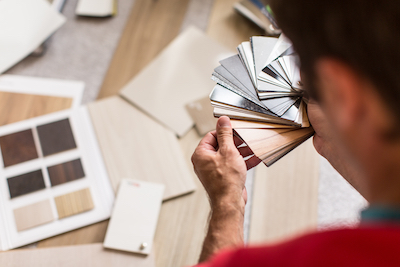Think linoleum and vinyl are the same? Think again. The two couldn’t be more different.
Vinyl was created in the 1930s from chips of synthetic resin called polyvinyl chloride. Linoleum is a natural based product made from renewable materials including linseed oil, tree resins, recycled wood flour, cork dust, and mineral pigments. It’s all mounted together on a jute or canvas backing.
 The first commercial linoleum was created by the American Linoleum Manufacturing Company in 1872. This water-resistant material didn’t take long to gain popularity throughout the US, becoming one of the most popular flooring choices in the late 19th and early 20th centuries. It made a great addition to high traffic areas, as well as moisture prone zones such as kitchens and bathrooms.
The first commercial linoleum was created by the American Linoleum Manufacturing Company in 1872. This water-resistant material didn’t take long to gain popularity throughout the US, becoming one of the most popular flooring choices in the late 19th and early 20th centuries. It made a great addition to high traffic areas, as well as moisture prone zones such as kitchens and bathrooms.
What made it spread quickly was its affordability factor. Yet at the same time, it was considered a luxurious material, being installed in some of the most sophisticated commercial properties of the early 20th century, including the Titanic.
But gradually, substitutes were created, and the popularity factor began to wane. Cheap vinyl alternatives could be designed more economically and offer more color and pattern choices because of the design practice. Still, there are many reasons to look back at this one-time favorite today.
Durability
Linoleum has almost double the lifespan of vinyl, lasting as long as 40 years with proper care. This can be attributed to its colorfast construction: the color and pattern are through the entire width of the material, printed on the surface like vinyl. Just be sure that the linoleum you have installed includes a protective coating to prevent the surface from darkening or taking on a yellow tinge, especially if it is exposed to direct sunlight. This protective top layer helps protect against dirt and scuffs, but keep in mind it is still susceptible to dents and tears, especially with high heels and furniture.
Water Resistance
Linoleum also offers water resistance you won’t find in other flooring choices, including wood. This advantage is what makes it a perfect choice for entryways and mudrooms, especially if you have a lot of wet shoes and snow covered boots. While you should never completely immerse linoleum in water, it’s perfect for light moisture and quick cleanups. With excessive moisture or humidity, you can begin to see edges and corners pull up, or seams to curl.
Eco-Friendly
Linoleum is a natural alternative to many other flooring choices. Linoleum is also easily recycled and biodegradable. Because of its wood components, it can easily be discarded in many different ways, even composting in your garden as you wood mulch or wood chips. And because it’s all-natural, it won’t emit any harmful VOC emissions either.
Is linoleum the right choice for your home?
